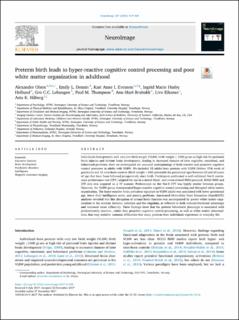| dc.contributor.author | Olsen, Alexander | |
| dc.contributor.author | Dennis, Emily L | |
| dc.contributor.author | Evensen, Kari Anne Indredavik | |
| dc.contributor.author | Hollund, Ingrid Marie Husby | |
| dc.contributor.author | Løhaugen, Gro | |
| dc.contributor.author | Thompson, Paul M | |
| dc.contributor.author | Brubakk, Ann-Mari | |
| dc.contributor.author | Eikenes, Live | |
| dc.contributor.author | Håberg, Asta | |
| dc.date.accessioned | 2021-04-27T07:23:10Z | |
| dc.date.available | 2021-04-27T07:23:10Z | |
| dc.date.created | 2018-01-19T13:25:51Z | |
| dc.date.issued | 2017 | |
| dc.identifier.citation | NeuroImage. 2017, 167 419-428. | en_US |
| dc.identifier.issn | 1053-8119 | |
| dc.identifier.uri | https://hdl.handle.net/11250/2739759 | |
| dc.description.abstract | Individuals born preterm with very low birth weight (VLBW; birth weight ≤ 1500 g) are at high risk for perinatal brain injuries and deviant brain development, leading to increased chances of later cognitive, emotional, and behavioral problems. Here we investigated the neuronal underpinnings of both reactive and proactive cognitive control processes in adults with VLBW. We included 32 adults born preterm with VLBW (before 37th week of gestation) and 32 term-born controls (birth weight ≥10th percentile for gestational age) between 22 and 24 years of age that have been followed prospectively since birth. Participants performed a well-validated Not-X continuous performance test (CPT) adapted for use in a mixed block- and event-related fMRI protocol. BOLD fMRI and DTI data was acquired on a 3T scanner. Performance on the Not-X CPT was highly similar between groups. However, the VLBW group demonstrated hyper-reactive cognitive control processing and disrupted white matter organization. The hyper-reactive brain activation signature in VLBW adults was associated with lower gestational age, lower fluid intelligence score, and anxiety problems. Automated Multi-Atlas Tract Extraction (AutoMATE) analyses revealed that this disruption of normal brain function was accompanied by poorer white matter organization in the anterior thalamic radiation and the cingulum, as reflected in both reduced fractional anisotropy and increased mean diffusivity. These findings show that the preterm behavioral phenotype is associated with predominantly reactive-, rather than proactive cognitive control processing, as well as white matter abnormalities, that may underlie common difficulties that many preterm born individuals experience in everyday life. | en_US |
| dc.language.iso | eng | en_US |
| dc.publisher | Elsevier | en_US |
| dc.rights | Navngivelse 4.0 Internasjonal | * |
| dc.rights.uri | http://creativecommons.org/licenses/by/4.0/deed.no | * |
| dc.title | Preterm birth leads to hyper-reactive cognitive control processing and poor white matter organization in adulthood | en_US |
| dc.type | Peer reviewed | en_US |
| dc.type | Journal article | en_US |
| dc.description.version | publishedVersion | en_US |
| dc.source.pagenumber | 419-428 | en_US |
| dc.source.volume | 167 | en_US |
| dc.source.journal | NeuroImage | en_US |
| dc.identifier.doi | 10.1016/j.neuroimage.2017.11.055 | |
| dc.identifier.cristin | 1547495 | |
| dc.relation.project | Norges forskningsråd: 237887 | en_US |
| dc.relation.project | Notur/NorStore: NN4651K | en_US |
| cristin.ispublished | true | |
| cristin.fulltext | original | |
| cristin.qualitycode | 2 | |

